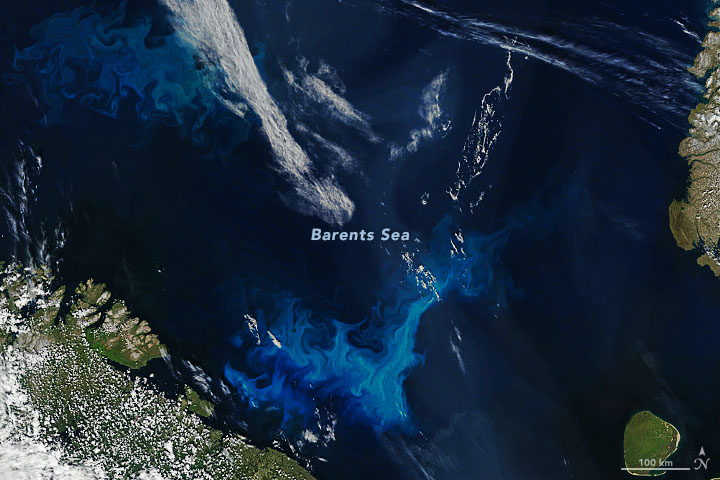Phytoplankton explode across the Barents Sea

Phytoplankton explode across the Barents Sea. Today’s Image of the Day from NASA Earth Observatory features a phytoplankton bloom in the Barents Sea, north of Scandinavia and Russia.
In the summer season, some parts of the Arctic Ocean which lose sea ice cover experience phytoplankton blooms that are so big and bright they can be seen from space.
Phytoplankton have exploded in numbers this year across the Barents Sea, as seen in this image that was captured on July 26 by the Moderate Resolution Imaging Spectroradiometer (MODIS) on NASA’s Terra and Aqua satellites.
Researchers at Stanford University recently found that the rate of growth of phytoplankton biomass increased by 57 percent from 1998 to 2008 in the Arctic Ocean.
“We were certainly surprised to see that phytoplankton biomass has begun to increase in the Arctic,” said Stanford biological oceanographer Kevin Arrigo. “Many people have been saying that with increased melt, nutrient inventories would decline, but that is not what we saw.” Phytoplankton explode across the Barents Sea. This is a rather shallow shelf sea, with an average depth of 230 metres (750 ft), and it is an important site for both fishing and hydrocarbon exploration. The Barents Sea is bordered by the Kola Peninsula to the south, the shelf edge towards the Norwegian Sea to the west, and the archipelagos of Svalbard to the northwest, Franz Josef Land to the northeast and Novaya Zemlya to the east. The islands of Novaya Zemlya, an extension of the northern end of the Ural Mountains, separate the Barents Sea from the Kara Sea.
The Stanford study is published in the journal Science.
—
By Chrissy Sexton, Earth.com Staff Writer
Image Credit: NASA Earth Observatory
News coming your way





















